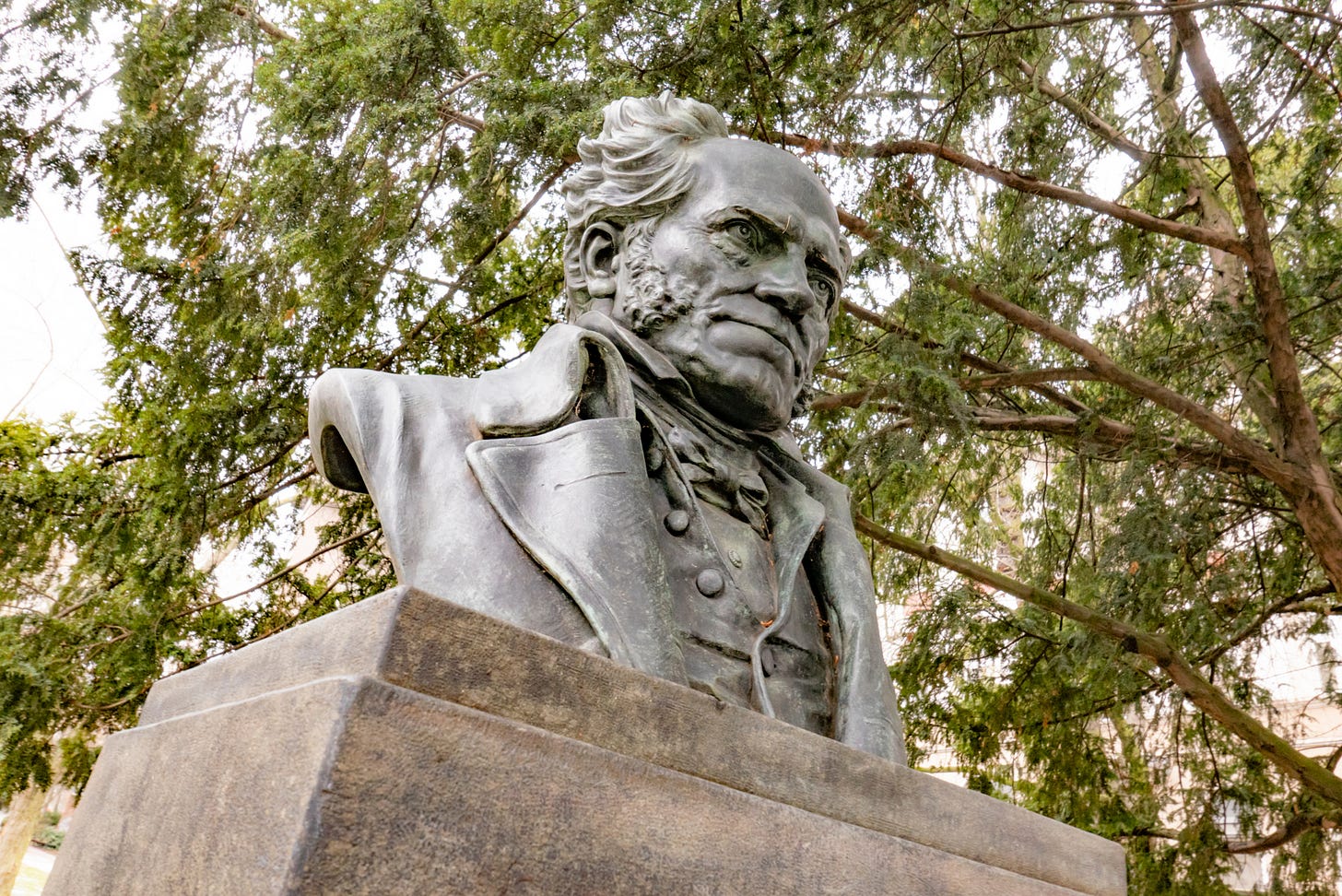Hi All!
Here is my weekly email discussing mental models, performance, business and entrepreneurship.
If you love this content (please share it), but also…
1. Connect with me on YouTube or Twitter
2. Subscribe to my shorter daily newsletter
-------------------------------------------------------------------------------------------
ZBiotics
I don’t drink as much as I used to (we’re all getting a little older here). But when I hate feeling miserable the next day.
I started to drink ZBiotics before I start drinking alcohol and it’s definitely helped me bounce back (like I used to when I was in university).
ZBiotics is a probiotic drink that helps me down alcohol and feel better tomorrow.
It’s engineered to reduce acetaldehyde, the main cause of hangovers, and improve my digestion and well-being.
ZBiotics is not a supplement or a cure, but a science-based solution that works with the body to enhance my natural abilities.
I love the science first approach and it’s also vegan, gluten-free, non-GMO, and made in the USA.
If you drink Zbiotics you can enjoy a glass of wine (or a shot of tequila) without worrying about the consequences.
Order here at ZBiotics.com/success and get 15% of your first order.
-------------------------------------------------------------------------------------------
The Hedgehog's Dilemma & Human Connection
We’re often told to embrace togetherness, to seek connection in our daily interactions, but what if I told you that keeping distance is sometimes the real key to a harmonious society?
In this unconventional journey, we are going to delve deep into a philosophy that might just change the way you perceive human interactions forever.
It All Started With Schopenhauer & Freud

The roots of the Hedgehog's Dilemma are buried deep in the soils of intellectual thought, sprouting first from the mind of Arthur Schopenhauer and later cultivated by Sigmund Freud.
Before we jump in, imagine a cold winter's day - a group of hedgehogs huddling together for warmth, but forced to remain apart to avoid hurting each other with their sharp spines.
This imagery, both vivid and somewhat contrary to our everyday narratives about relationships and intimacy, forms the crux of the Hedgehog's Dilemma.
Like hedgehogs seeking warmth but using their spines to maintain distance, individuals strive to foster close relationships while still preserving their autonomy.
Schopenhauer, a powerhouse of philosophical thought, first introduced this analogy to illustrate the balance between intimacy and self-preservation, a dance of coming close for warmth and retreating to avoid the pricks of too close an encounter.
Freud, the father of psychoanalysis, later adopted this paradoxical thinking, utilizing it as a springboard to explore the intricate nuances of human relationships and individual psychology.
The Hedgehog's Dilemma
Now I’m sure dropping Schopenhauer and Freud is taking some of you back to college, but hear me out for a second.
Surprisingly enough (not surprising), these two powerhouses of thought were onto something… that seems to have been forgotten.
So let’s do this, I want to break it down a little bit more. Show you how this plays out in real life and then we’ll discuss how to leverage this mental model to help better optimize and understand your own relationships.
Remember, the Hedgehog's Dilemma is a mental model.
A framework to help you better understand why you do what you do. It will not change anything overnight, but it will give you clarity on why certain relationships feel the way they do, why you may feel compelled to pull away when trying to get close to someone.
Use it as a lens to examine your behaviors and tendencies, not as an excuse.
With understanding comes the power to make different choices.
I want you to do this.
Picture yourself as one of those hedgehogs.
You have an intrinsic need for warmth, for connection, but at the same time, you harbor a natural, self-protective instinct.
This is the essence of the Hedgehog's Dilemma: a narrative that teaches us the importance of finding our comfortable distance in relationships, a distance that respects individual boundaries while fostering connections.
By internalizing this concept, we can start to view human relationships through a lens that honors both individuality and community, that recognizes the need for self-preservation alongside the pursuit of connection.
This isn't just about hedgehogs (obviously); it's about us, navigating the complex terrains of modern relationships, armed with insights that encourage balanced, harmonious connections.
Let’s dive into this little bit of very useful (but IMO, mostly forgotten) wisdom.
Why Do We Love/Hate Other People?

When you really boil it down, the push and pull of the Hedgehog's Dilemma comes from two core human needs that are always in tension - our drive to connect vs our need to stand apart.
Our deep desire for close relationships evolved because bonding and teamwork helped humans survive back in the day.
But we also needed to act independently at times, so self-preservation got wired in too.
This tension got baked into our brains.
Too much intimacy can feel rewarding but also anxiety-provoking when we feel like we're losing our identity.
Isolation leaves us feeling free but also lonely and rudderless without social bonds to anchor us.
Our brains light up when we bond, releasing feel-good chemicals like oxytocin that bring comfort and safety.
But rejection activates pain centers, since we're wired to need social connections.
At the same time, autonomy fires up our dopamine and ego, which provide a sense of personal power and coherence.
So the Hedgehog's Dilemma perfectly captures this tug-of-war written into our social wiring - the need to come together versus remain apart, stay connected versus assert independence.
We're always trying to strike that balance as we move through different types of relationships and phases of life.
The Hedgehog Dilemma in Modern Life
Now let’s fast forward and look at how to apply the Hedgehog’s Dilemma to balance intimacy and autonomy in key relationships today.
Friendships
Friendships require nurturing bonding experiences together, yet research shows too much closeness can breed resentment.
Friends who spent every free minute together experienced greater conflict.
Scheduling regular one-on-one time is important, but so is respecting each other’s need for space.
Studies show time apart makes friends appreciate each other more.
Actionable Tips:
Romantic Partnerships
Romantic relationships involve intricate dances between affection and autonomy.
John Gottman’s research reveals satisfied couples build intimacy yet retain a sense of separateness.
Taking a couples’ attachment style quiz can provide insight into innate needs for closeness vs. independence.
Actionable Tips:
Family Relationships
Families require balancing unconditional love with respect for personal boundaries as children grow.
Research by child psychologist Dr. Gordon Neufeld highlights the importance of honoring the separateness of family members.
Actionable Tips:
Maintain family traditions, but allow flexibility. Adapting traditions to members’ changing needs shows respect, but are very important for relationships and health.
Professional Relationships
Even workplace relationships demand equilibrium between collegiality and productivity.
Leaders seen as too personal are considered less professional. But leaders that are not personal at all, are less trusted.
Actionable Tips:
What The Dilemma Means For You
Distill Personal Truths: In the pursuit of authentic relationships, encourage deep self-inquiry to understand your core values and expectations. This foundational work aids in building connections that are truly harmonious, avoiding the mirage of superficial compatibility.
Adopt a Dual Focus Strategy: Cultivate the ability to maintain a dual focus - preserving your individuality while nurturing the relationship. This involves a continuous process of balancing personal growth with the nurturing of relationships, creating a space of mutual respect and development.
Craft a Communication Blueprint: Develop a communication blueprint that clearly outlines the modes and frequencies of communication that foster healthy relationships. This strategy prevents misunderstandings and fosters a space of open dialogue and understanding.
Engage in Regular Emotional Audits: Incorporate regular emotional audits within your relationships, where you take time to assess the emotional health of the relationship, identify areas of improvement, and work together to foster greater harmony and understanding.
Develop a Trust Framework: Build a trust framework within your relationships that clearly outlines the actions and behaviors that foster trust. This guideline serves as a roadmap for building and maintaining trust, preventing betrayals and misunderstandings.
Implement Collaborative Problem-Solving: Embrace collaborative problem-solving strategies that encourage diverse perspectives and innovative solutions. This approach not only fosters a sense of collaboration but also nurtures a culture of respect and mutual growth.
Foster a Culture of Psychological Safety: In professional settings, advocate for the creation of environments that foster psychological safety, encouraging individuals to share their insights and ideas without fear of retribution, fostering innovation and collaboration.
Strategic Boundary Management: Develop strategies for establishing and maintaining personal and professional boundaries. This involves crafting clear guidelines on the limits of your availability and engagement, fostering relationships that respect individual space and autonomy.
It's about using the wisdom in the Hedgehog's Dilemma to build connections that are not just strong and fulfilling, but also resilient to the fast-paced changes around us.
It's about making smart moves in relationships, being more in tune with yourself and others, and ultimately creating bonds that stand the test of time.
If you enjoyed this article, I’d love to hear from you.
Write me at scott@scottdclary.com or tweet at me @ScottDClary and I’ll do my best to get back to everyone!
-------------------------------------------------------------------------------------------
Other Partners (They Have Some Special Offers For Readers.. Check Them Out)
HUBSPOT — https://hubspot.com/successpod
MY FIRST MILLION PODCAST — https://www.youtube.com/@MyFirstMillionPod/
MASTERWORKS — https://masterworks.art/successstory (Early Access)
SHOPIFY — https://shopify.com/successstory/
NETSUITE — https://netsuite.com/scottclary/
FACTOR — https://factormeals.com/successpod50 (Code successpod50)
BLINKIST — https://blinkist.com/clary
MUNCH — https://www.getmunch.com/ (Promo Code: Success)
ZBIOTICS — https://zbiotics.com/success (Code: success)
My Links
Success Story (Top 10 Business Podcast)
-------------------------------------------------------------------------------------------
Subscribe to get this newsletter in your inbox, every week.